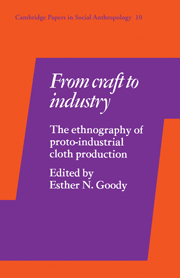Book contents
- Frontmatter
- Contents
- List of figures, maps and illustrations
- List of tables
- Notes on contributors
- 1 Introduction
- 2 On commoditization
- 3 Daboya weavers: relations of production, dependence and reciprocity
- 4 The tailors of Kano City
- 5 Production and control in the Indian garment export industry
- 6 Harris Tweed: construction, retention and representation of a cottage industry
- Notes
- References
1 - Introduction
Published online by Cambridge University Press: 04 August 2010
- Frontmatter
- Contents
- List of figures, maps and illustrations
- List of tables
- Notes on contributors
- 1 Introduction
- 2 On commoditization
- 3 Daboya weavers: relations of production, dependence and reciprocity
- 4 The tailors of Kano City
- 5 Production and control in the Indian garment export industry
- 6 Harris Tweed: construction, retention and representation of a cottage industry
- Notes
- References
Summary
THE DIVISION OF LABOUR AND INVESTMENT IN PRODUCTION
Both Adam Smith and Karl Marx were fascinated by the way in which the process of production had been subdivided and specialized in eighteenthand nineteenth-century industry. Smith describes the way in which the making of pins was broken down into 18 separate operations, which could be carried out by as many workers with an astonishing 240-fold increase in productivity, using the same technique and tools (Adam Smith 1776: vol. 1, 6-7). Marx was intrigued by the different forms of cooperation which could occur in articulating the tasks separated by the division of labour. He saw this in a highly formal way, distinguishing between organic manufacture, in which the basic raw material passes through a sequence of stages in which it is converted into the finished product (pin-making would be one example), and heterogeneous manufacture. The making of a watch is used as an example here. It used to be the individual product of one craftsman. Then (in the nineteenth century) it became the social product of a large number of detail workers; there were mainspring makers, dial makers, hairspring makers, jewelled-hold makers, ruby-lever makers, case makers, screw makers and gilders. And these had numerous subdivisions: among wheel makers the makers of brass wheels and the makers of steel wheels were distinct (Marx 1954:360). No advantage was seen in bringing these processes together under one roof: there were fewer overheads with outworkers, and more competition amongst them.
- Type
- Chapter
- Information
- From Craft to IndustryThe Ethnography of Proto-Industrial Cloth Production, pp. 1 - 37Publisher: Cambridge University PressPrint publication year: 1982
- 4
- Cited by



